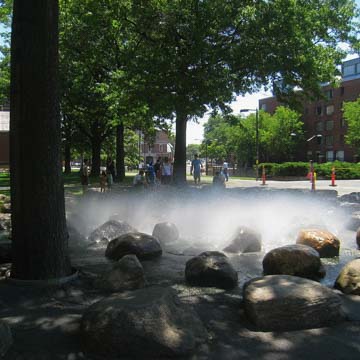Tanner Fountain is an influential example of late-twentieth-century efforts to revive landscape architecture as an art. The movement, which has not yet received extensive historical analysis and does not have a widely recognized name, arose at Harvard’s Graduate School of Design under Peter Walker’s tenure as chair of the Landscape Architecture Department (1978–1981). Reacting against the increasing dominance of formulaic problem-solving approaches to landscape design during the 1970s, the work of Walker and his students often blurred the line between landscape architecture and land art, modernism, and postmodernism. In a 1997 essay, Walker explained that he sought to make “environments that are serene and uncluttered, yet still expressive and meaningful.”
In 1984, Harvard University approached Walker, a founder of the firm Sasaki, Walker and Associates (SWA), after the school received funding for a new fountain. Walker selected a site in front of the Harvard University Science Center, an important campus crossroads just north of the Harvard Yard. Designed in collaboration with sculptor Joan Brigham, Tanner Fountain is a 60-foot-diameter circle filled with 159 loosely spaced granite boulders. These boulders sit atop what was already on the site, a mixed landscape of grass, trees, and asphalt. The granite boulders, ever present throughout New England, were meant to recall early settlers’ struggles to clear the region’s fields for agriculture. The design was also inspired by the environmental artworks of Carl Andre and others. But the real focus of the fountain design was how it would function as a social space. The boulders are sunken in the ground with smooth sides facing up, approximately 16-18 inches above the ground surface—a typical seating height.
The fountain does not have a pool or basin where water collects. Harvard’s president had observed that other campus fountains had been turned off after their basins broke during maintenance, many of them subsequently filled with soil and flowers. To avoid that kind of scenario, Tanner Fountain features thirty-two nozzles embedded in the asphalt paving that emit a cool cloud of mist that lingers over the center of the stone circle during warm weather. A thin film of water clings to the asphalt before flowing into a drain and recirculating through the fountain.
In 2008, the American Society of Landscape Architects honored Tanner Fountain with its Landmark Award, which recognizes a project that has retained its design integrity and contributed to its community. In the description of the project submitted for the award, Tanner Fountain’s lack of a traditional basin was called “an innovation that transformed fountain design.” While this observation is frequently repeated, and the high visibility of the Tanner Fountain certainly helped to popularize basin-less fountains, precedents do exist, including a number of similarly designed water features for children, such as the Washington Plaza fountain (1960s, Conklin and Rossant Architects) in Reston, Virginia.
More distinctive than Tanner Fountain’s lack of a basin was its use of steam in the winter months, though this had precedents in the artist Robert Morris’s installations in Washington state. The steam at Tanner Fountain is recycled from the university’s central heating system and emits from the same nozzles as the mist. Brigham had conducted a number of experiments with steam prior to this project but this was her first permanent work to use steam. After her successful use of steam at Harvard, she became a major promoter of the medium and collaborated on numerous steam-emitting fountains in the years that followed.
In an article published shortly after the fountain was completed, Brigham told the writer Jory Johnson that the clouds of mist and steam were intended to provide aesthetic continuity by creating a similar effect in different seasons using different media. Conversely, Alan Ward’s widely published photographs of the fountain and later essays have celebrated how the fountain changes with the seasons and weather. Rainbows are visible in the mist during sunny summer days and a layer of snow often covers the stones during the winter months.
References
Anderton, Francis. “Avant-Gardens.” Architectural Review,September 1989.
“ASLA 2008 Professional Awards, The Landmark Award, Tanner Fountain.” American Society of Landscape Architects.Accessed June 28, 2015. www.asla.org.
Brigham, Joan. “Steam Heat: Winter Fountains in the City.” Places6, no. 4 (1990): 43-49.
Dattner, Richard. Design for Play.New York: Van Nostrand Reinhold, 1969.
Eastman, Susan Rausch. “Coining a Phrase.” Landscape Architecture, January 1982.
Gillette, Jane. “Biography of Peter Walker.” The Cultural Landscape Foundation. Accessed March 4, 2017. www.tclf.org.
Johnson, Jory. “The Presence of Stone.” Landscape Architecture, July/August 1986.
“The Rehabilitation of Washington Plaza.” American Society of Landscape Architects. Accessed June 28, 2015. www.asla.org.
Simony, Christine. “The Tanner Fountain.” TOPOS65 (2008): 98-101.
“Tanner Fountain, Harvard University.” PWP Landscape Architecture. Accessed June 28, 2015. www.pwpla.com.
Walker, Peter. “Classicism, Modernism, and Minimalism in the Landscape.” In Peter Walker: Minimalist Gardens, edited by Leah Levy, 17-23 .Washington, D.C.: Spacemaker Press, 1997.





